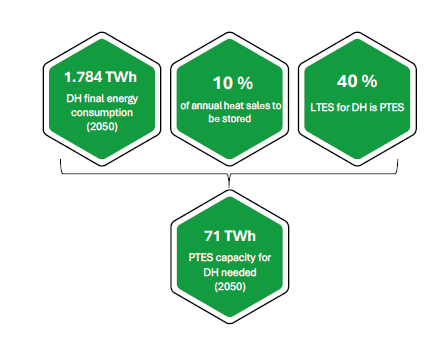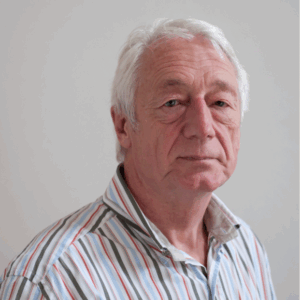Treasure project accelerates pit thermal energy storage expansion across Europe
November 10, 2025
Pit thermal energy storage (PTES) represents a key enabling technology in future heating networks powered by fluctuating renewable energy sources. These storage systems provide a cost-effective solution for storing surplus thermal energy over periods ranging from days to entire seasons. Currently, there are eight PTES installations in operation in Europe. The EU funded Treasure project is focused on accelerating the deployment of PTES by shortening project development times. Treasure will support the construction of seven PTES systems and help plan 20 satellite projects. The Treasure consortium has also projected the demand for PTES in Europe by 2050, estimating that 8,100 storage facilities with an average volume of 250,000 m³ each will be needed to store 10 % of the total district heat. The image shows the first of a new generation PTES during construction in Høje Taastrup, Denmark. It features a special lid design, an innovative inlet and outlet and a custom-developed polymer liner. Photo: Ioannis Sifnaios (DTU)
“The PTES market is just at the beginning of a steep growth curve. Treasure’s Industrial partners are already seeing strong demand from utility companies across Europe”, confirmed Hendrik Wetzel from PlanEnergi, Denmark, a key partner of the Treasure project. Wetzel notes that it took eight years, from 2011 to 2018, to build the first six of the PTES currently in operation worldwide, supplying district heating, most of which have been built in Europe. Looking ahead, he anticipates the implementation of at least 25 additional PTES systems in Europe alone over the next five to ten years.
| Site, country | Volume of PTES | Year of finalization |
| Marstal, Denmark | 75,000 m3 | 2011-2012 |
| Dronninglund, Denmark | 60,000 m3 | 2013 |
| Gram, Denmark | 125,000 m3 | 2014-2015 |
| Vojens, Denmark | 210,000 m3 | 2014-2015 |
| Toftlund, Denmark | 85,000 m3 | 2016-2017 |
| Langkazi, Tibet, China | 15,000 m3 | 2018 |
| Høje Taastrup, Denmark | 70,000 m3 | 2023 |
| Carwarp, Australia | 15,000m3 | 2023 |
| Lidzbark Warminski, Poland | 15,000 m3 | 2023 |
| Bracht, Germany | 26,600 m3 | 2025 |
List of commercial pit thermal energy storage (PTES) projects in operation Source: PlanEnergi
Most of the PTES systems of the first generation were built to store surplus solar heat from the summer for space heating in winter. Høje Taastrup, Denmark, is the first large-scale PTES to be operated as short-term storage with storage cycles of several weeks. The storage is connected to the Copenhagen district heating grid and started operating in February 2023. It features an innovative lid construction (see photo below) which is also used in Marstal and Dronninglund.

Figure 1: View of the storage pit at Høje Taastrup from above. The lid is divided in squares with a gradient towards the centre of each square, in which a pumping well directs the rainwater away from the entirety of the lid. The gradient of each module was created using varying levels of pebbles
Photo: Ioannis Sifnaios (DTU)
Optimized lid construction minimizes heat losses
The 70,000 m3 heat storage pit has a capacity of around 3,300 MWh at a temperature range of 48 °C to 90 °C. It is intended to reduce expensive peak loads in the district heating network Høje Taastrup Fjernvarme. The storage pit is charged by the main district heating transmission grid, which is operated at 110 °C, and discharged to the local distribution grid via heat exchangers. A number of sensors monitor the operation and performance. Analysis has shown that the storage pit was charged with 22,934 MWh over the course of 2024 and 21,109 MWh were discharged. This equates to an annual efficiency of 89 % over a total of nine charging cycles. “The monitoring data shows that there was very little operation of the storage tank between August and October 2024 due to low heat demand in the district heating grid. But expansion of the grid will continue in the coming years, so the head load is expected to increase”, explained Ioannis Sifnaios, Researcher at the Technical University of Denmark, who was in charge of evaluating the measurements.
The top layer of the storage tank had an average temperature of 84 °C in 2024. The top layer of the water was never measured hotter than 90 °C, while 68% of the time the temperature was higher than 85 °C and 88% of the time it was higher than 80 °C. According to Sifnaios this operating range is expected to positively affect the liner’s lifetime.
The monitoring also shows that the new construction of the lid with the rainwater pumps in the centre of each square works as expected (see figure 1), with only 30 % of the total heat loss occurring through the lid.
Enormous market potential for PTES needed in district heating by 2050
“We aimed to estimate the demand for PTES plants and related high-temperature-resistant geomembranes by 2050 to stimulate research and innovation within the geomembrane industry”, explained Wetzel, outlining the motivation behind the assessment illustrated in Figure 2.
The framework for demand estimation is provided by the local heating sector in Europe. An exponential increase is assumed here over the next three decades, meaning that by 2050, half of Europe’s heating requirements could already be covered by local heating. This means a four-fold increase from 446 TWh district heating final energy consumption in 2018 to 1,784 TWh in 2050. Of this, 10 % will be stored, with PTES contributing 40 %. This translates to 71 TWh of PTES capacity dedicated to district heating.
“To calculate the necessary storage volume for 71 TWh of stored heat we have set a temperature range of 60 to 90 °C”, Wetzel added. The required PTES storage volume by 2050 is therefore estimated at 2 billion m³. If the average storage pit size is 250,000 m³, approximately 8,100 PTES installations would be required across Europe.
In conclusion, the growing demand for PTES systems presents a substantial opportunity for innovation, investment and the development of high-performing geomembranes, which will be crucial in meeting Europe’s ambitious district heating goals by 2050.

Figure 2: Assumptions for calculating the potential of PTES in district heating by 2050 Source: PlanEnergi
Scientific papers quoted in this news article:
Ioannis Sifnaios, Adam R. Jensen, “Performance analysis of the Høje Taastrup water pit thermal energy storage”, 30 September 2025, https://www.sciencedirect.com/science/article/pii/S2352152X25022170?via%3Dihub
Hendrik Wetzel, Wim van Helden, Per Alex Sørensen, Vincent Micollier, “Geosynthetics, a key brick of the energy transition”, 1 September 2025, https://zenodo.org/records/17175630
Websites of organizations mentioned in this news article:
Treasure: https://www.treasure-project.eu/
PlanEnergi: https://planenergi.eu/
Technical University of Denmark: https://www.dtu.dk/english/


